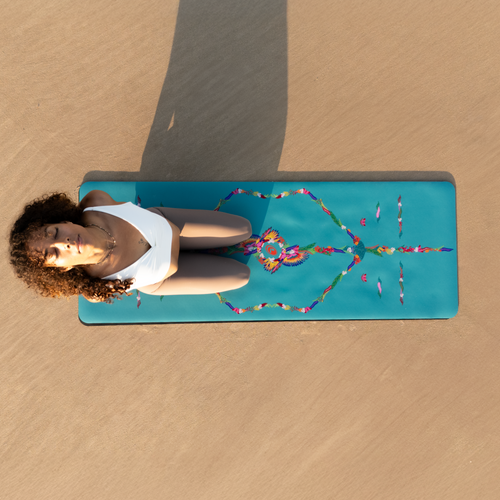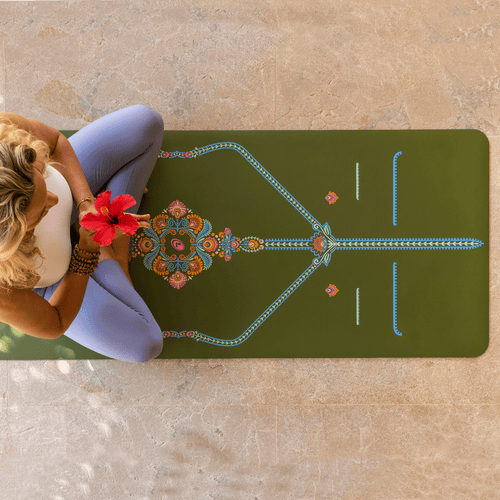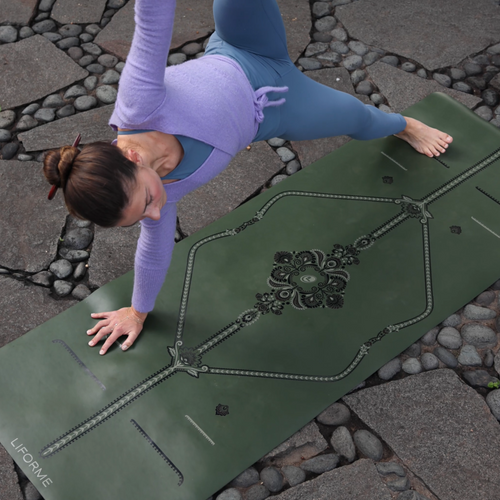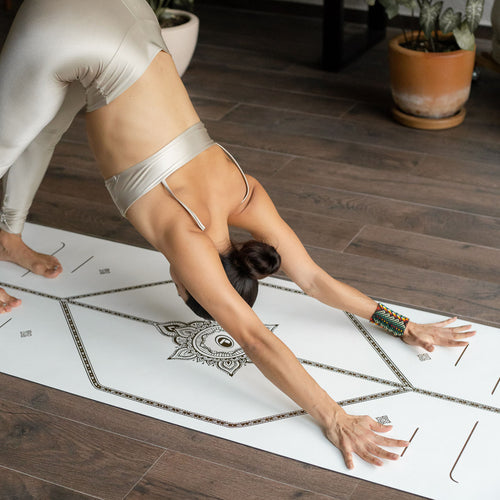What’s stopping you from trying yoga? Do you think it’s too expensive, too time consuming, that you aren’t flexible enough? These are just a few of the commonly held misconceptions that keep people from starting a practice that has so many wonderful benefits. So, we’re going to do a little myth-busting and break down the barriers that are keeping you from stepping onto a yoga mat and beginning the journey toward better health and well-being.
Yoga is hard to start doing.
Starting yoga is as easy as unrolling your mat and stepping onto it. What can be hard is getting over your fears and preconceived ideas about what happens next. If you’ve never done yoga before, get yourself in the door at your local studio and the rest will take care of itself.
You have to go to a studio to do yoga.
Yoga is available in many different settings: studios, gyms, workplaces, and your very own living room, just to name a few. There are pros and cons to each of these, including affordability, convenience, and community. You want to find the right combination of these factors that works best for you.
Don’t avoid yoga studio classes because you are worried about being judged or not belonging. Quite the opposite is usually true! Studio classes are often the best way to begin yoga because they offer teachers with the most expertise. Also, all yoga studios are not the same. It’s a good idea to try a few before you decide the studio is not for you.
 Yoga can be taught by anybody.
Yoga can be taught by anybody.
Yoga lacks an international credentialing process for teachers, so technically anyone can teach yoga, but it’s not a good idea to take a class from just anyone. There are lots of weekend certifications that exercise instructors take as an ‘add-on’ to their resumes.
Most yoga studios require their teachers to have much more extensive training, which is another reason why studio classes are well worth it. In any setting, look for teachers with at least a 200-hour yoga certification.
I will be judged in classes if I’m new.
Every single person who does yoga was once in your position: the newbie stepping nervously into their first class. If anyone notices that you’re new, they’ll likely go out of their way to be extra welcoming and be excited that you’re embarking on this journey that has served them so well.
Take beginners’ classes when possible and tell the teacher that you’re new. If you do find yourself in a more advanced class, do what you can and receive your first lesson in not comparing your practice to others. And if you find the yoga students or teachers to be judgey, take your business elsewhere.
Props are discouraged in yoga.
Props are encouraged and should be embraced as the amazing tool that they are for beginners and advanced students alike.
First of all, what are props? In yoga, this term refers to blocks, blankets, bolsters, straps, and even chairs and walls, all of which can be used to support your body in the optimal alignment for each pose. Props should consider rebranding as tools because that’s what they really are: things that help you get the job done right.
In the past, some types of yoga may have looked down on props or thought them unnecessary, but as the importance of alignment has been increasingly embraced, props are most often recognised as an asset to any yogi.
 Some yoga poses are better than others.
Some yoga poses are better than others.
All yoga poses are created equal. Though yoga teachers may refer to some poses as advanced, it’s not intended as a value judgement on the yogi, but more to set realistic expectations of when the average student might feel ready to tackle them. A new student who has a background in gymnastics or dance might get to those poses much sooner than one who doesn’t, though both are considered yoga beginners.
One of yoga’s primary gifts is encouraging the development of a sense of your personal journey free from comparison. Part of this is accepting your body as it is and finding the right poses for it on any given day, which requires you to release judgment of yourself and others.
You need to already be flexible.
Absolutely false. Yoga is not gymnastics. It’s not a competition to see who has the loosest hamstrings at the starting line. It’s not even a competition to see who has the loosest hamstrings at the finish line, since there is no finish line. Being flexible does not make you ‘good’ at yoga. The less flexible you are when you start, the more room for improvement you have. It’s the tightest people in the room that can benefit the most from yoga.
You need to be thin to do yoga.
Also totally false. Yoga does not care about your weight one bit. People of all shapes and sizes can do yoga, aided by props when necessary.
 Yoga is only for women.
Yoga is only for women.
It’s true that today, more women than men do yoga. The Yoga Journal/Yoga Alliance 2016 Yoga in America survey found that 72% of yoga practitioners in the United States were women. However, modern yoga’s origins were distinctly male-dominated. The father of modern yoga, T. Krishnamacharya, created a yoga school for boys in Mysore, India in 1926, which he ran for the next 20 years. His students included B.K.S. Iyengar and Ashtanga founder Pattabhi Jois, both of whom profoundly influenced the yoga we do today.
So, it would not be correct to say that yoga is somehow better suited to women’s bodies. People of all genders can benefit greatly from practising yoga.
Yoga is expensive.
There’s a bit of truth to this one but also a lot of workarounds to get the price down. If you’re not familiar with the cost of exercise classes, expect a little sticker shock when you see the price of a single yoga studio class, but remember that in the cases of most local, independent yoga studios, no one is getting rich. They are trying to pay their rent and give their teachers a living wage.
Here are a few of our best tips and tricks to save money:
- Purchasing a pack of 10 or 20 classes often significantly reduces the cost per class. A monthly pass may also break your way if you go frequently enough.
- Look for ‘community classes’, which are low-cost or even free. These may be taught by teacher trainees.
- Donation yoga classes or studios that allow you to pay what you can are available in many areas.
- Signing up for a beginner’s series of classes will often get you a discount.
- If you belong to a gym, check out their yoga offerings. Look for fully qualified yoga teachers.
- Some workplaces offer yoga classes as a perk.
- Online classes are much more affordable.
- Once you are more experienced, you can practice independently at home.
Yoga is always spiritual.
It depends on what you mean by spiritual. It’s not at all difficult to find yoga classes that are completely focused on the physical practice and do not mention a thing about spirituality. Today’s yoga won’t force any belief system on you, but the door is open for you to bring in your own spirituality, whether in a traditional religious sense or more abstract feelings of connection with something beyond yourself. It’s really down to the individual.
Yoga will take up too much of my time.
This seems to be a classic case creating a problem before it exists. The subtext here is ‘yoga is boring’, which just means you haven’t found the yoga that works for you yet. There are so many different styles, and each teacher has their own vibe, so try a few more before you write yoga off, because once you find one that clicks, you’ll be looking for ways to spend more time doing yoga, not less. That said, yoga gives back what you put in. If you only have an hour once a week or 15 minutes a day, you’ll still benefit from yoga as long as you do it consistently.
 Yoga is dangerous.
Yoga is dangerous.
Yoga is not inherently any more dangerous than any other physical activity. The chance of injury is mitigated by learning to listen to your body and practice with optimal alignment. For beginners, the primary danger is trying to do too much too quickly without first building the necessary underlying strength and flexibility. A good teacher can help you rein it in and offer the appropriate props at the right times.
Sometimes long-time yogis develop repetitive stress injuries, which can require rehabilitation. Try from the beginning to avoid developing attachment to the achievement of any particular postures and use all the tools for good alignment that are available to you, including a yoga mat with an integrated alignment system.
Yoga is just about poses.
Yoga is more than the poses, though they create the backbone of the physical practice. Even if you choose a yoga style that focuses primarily on asana, you’ll soon discover that yoga also engages your awareness, which may lead you to mental or spiritual planes. If practices beyond asana appeal to you, there are ample opportunities to explore things like breathwork and meditation under the yoga umbrella.
In yoga’s history, postures were considered only a small part of the practice (read more about yoga’s Eight Limbs). It’s only in modern times that yoga has become synonymous with poses.
Yoga is just a workout.
Yoga is more than a workout, though you will definitely experience its effects in your body. Unlike many workouts that prompt you to zone out, distract your mind with music or videos, and grit your teeth through discomfort, yoga encourages you to fully engage your mind in the physical sensations of your body and react to the feedback you are getting. This is how yoga strengthens the body-mind connection, which helps you not only get a workout but also a holistic experience.
Yoga is just complex stretching.
Yoga is more than complex stretching, though the physical postures will challenge your body in new ways. Yoga’s focus on alignment improves your body awareness, allowing you to translate verbal and visual instructions into physical actions. This also encourages a new awareness of your body’s capabilities and limits, the boundaries of which can then be safely pushed.
Yoga poses engage your whole body rather than narrowly focusing on one area. You will undoubtedly find yourself in some new positions in yoga, but that’s the fun of seeing what your body can do.
 Yoga is just a trend.
Yoga is just a trend.
If so, it’s a trend with extraordinary longevity! Even if we disregard the ancient roots of yoga (which seems fair, since in many ways it was a very different practice), yoga’s current global rise began in the 1970s when Indian yoga teachers began attracting Western students who then returned home, disseminating what they had learned. Yoga’s popularity has only grown since then, making it clear that yoga is here to stay, with or without goats. ;)
What’s the reality of yoga?
Yoga is nothing to be frightened of. Just like any new thing that you try, expect a bit of a learning curve as you get used to the vocabulary and new positions for your body. But it doesn’t take very long to get up to speed. Yoga is noncompetitive and individualized, so jump in as casually or intensively as you wish. Reviewing our Complete Beginner’s Guide will help you get your nerve up and prepare you for your first classes. Beginning your yoga journey is such an exciting place to be. You have so much to gain from this wonderful practice.
Yoga Myths, Busted
Wow, there really are a lot of misconceptions about yoga circulating out there! Most of them come from places of fear of the unknown and worry that you will not fit in. These are very natural human concerns that can be overcome with more information, which we’ve offered above. We hope you feel more empowered to try yoga and that you’ll soon love it as much as we do!





































